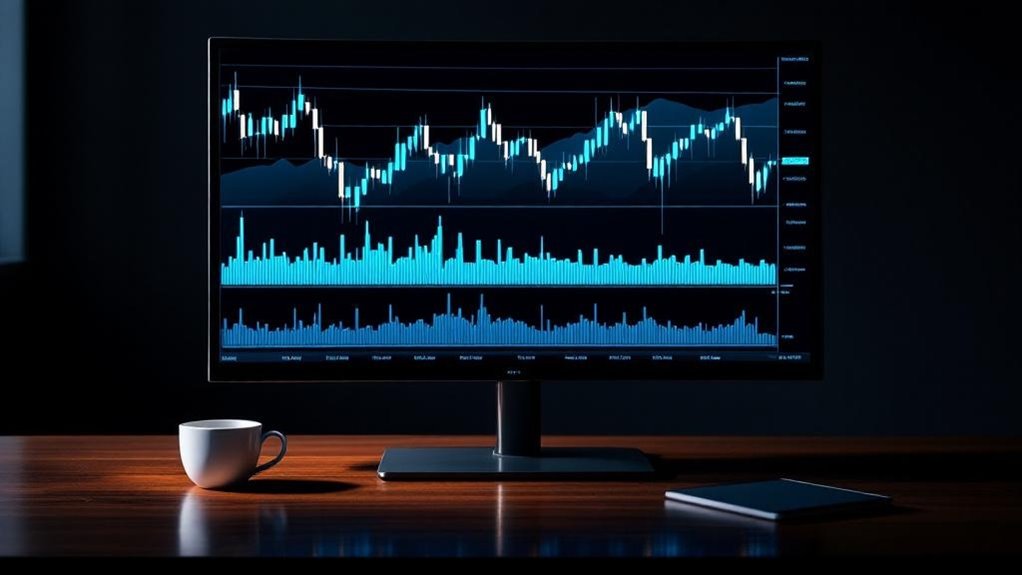Trading volume analysis serves as a critical component of market timing strategy by measuring the total quantity of shares traded during specific intervals. Professional traders utilize volume indicators like On-Balance Volume and Volume Weighted Average Price to confirm price movements, identify trend strength, and validate breakouts. High-volume price movements typically signal stronger trends and more reliable breakouts, while low-volume patterns often precede reversals. Understanding these volume dynamics reveals deeper insights into institutional participation and market psychology.
Key Takeaways
- Trading volume confirms price movements and market trends, serving as a critical indicator for validating the strength of market direction.
- Rising volume during price advances indicates strong bullish trends, while declining volume suggests potential trend weakness or reversals.
- High-volume breakouts occurring 50% above the 20-day average provide more reliable trading signals than low-volume price movements.
- Volume analysis across multiple timeframes reveals institutional participation patterns and helps identify genuine market momentum versus false signals.
- Price-volume divergences at critical market levels signal potential trend reversals and provide strategic entry and exit points.
The Core Fundamentals of Trading Volume

Trading volume stands as a cornerstone metric in financial markets, representing the aggregate quantity of shares, contracts, or units exchanged between buyers and sellers during specified trading intervals. This fundamental measure provides vital insights into market activity and liquidity conditions.
Volume Types encompass various categories, from standard exchange-reported trades to specialized dark pool transactions, while Volume Trends reveal underlying market dynamics and participation levels. High-frequency traders contribute significantly to daily trading volumes, shaping modern market activity.
Professional traders rely on sophisticated Volume Indicators, including On-Balance Volume and Volume Weighted Average Price, to validate price movements and identify potential market turning points.
Volume Metrics serve as essential tools for measuring market health and efficiency, with higher volumes typically indicating enhanced liquidity and narrower bid-ask spreads. Market participants monitor these metrics across different timeframes – from intraday to weekly periods – to gauge trading activity and market sentiment effectively.
Through thorough volume analysis, investors can better understand market dynamics and make more informed trading decisions.
Volume Signals and Price Movement Correlations
In financial market analysis, the relationship between trading volume and price movements provides critical signals for determining trend strength and potential reversals.
Volume serves as a primary confirmation indicator, with rising volume during price advances typically validating bullish trends while declining volume during price increases may signal diminishing momentum. Analyzing price-volume patterns helps investors anticipate future market trends and make more informed trading decisions.
The reliability of price breakouts, whether bullish or bearish, is substantially enhanced when accompanied by above-average trading volume, while consistently low volume during price movements frequently serves as an early warning sign of potential trend weakness or imminent reversal. Market breadth tools like the Advance-Decline Line can provide additional confirmation of volume signals by showing the degree of broad market participation in price movements.
Volume Confirms Price Trends
While successful market analysis relies on multiple factors, volume serves as a critical confirmation tool that validates price movements and trend reliability.
Through thorough market participation analysis, traders can assess the conviction behind price movements by examining volume trend indicators alongside directional changes.
Strong price trends accompanied by high trading volume demonstrate robust market participation, validating the sustainability of the current direction.
When volume increases during upward price movements, it signals growing demand and reinforces bullish sentiment among market participants. Monitoring the Volume Rate of Change helps investors avoid making decisions based on temporary market fluctuations.
Conversely, declining volume during price advances may indicate weakening momentum and potential trend exhaustion, warranting closer scrutiny of positions.
Volume spikes often precede or coincide with significant price movements, reflecting decisive shifts in market sentiment and providing valuable confirmation of trend strength or imminent reversals.
Similar to oscillator indicators like RSI and MACD, volume analysis helps traders identify potential market reversals and confirm trend strength.
High Volume Price Breakouts
High-volume price breakouts represent a critical intersection of market dynamics, where substantial trading activity converges with decisive price movements to signal potential trend shifts and trading opportunities.
When trading volume surges at least 50% above the 20-day average during a breakout, the probability of sustained directional movement increases considerably. Above-average volume provides essential confirmation that a breakout is genuine rather than a fakeout.
These high volume anomalies often mark pivotal moments where supply and demand forces realign, particularly when price penetrates established support or resistance levels.
Understanding market psychology through price action analysis can help traders better anticipate and validate these high-volume breakout scenarios.
Successful breakouts require continued elevated trading activity following the initial surge, with particular attention paid to volume patterns during breakout retests.
Analysis of secondary volume characteristics, including On-Balance Volume (OBV) and Chaikin Money Flow (CMF), provides essential confirmation of breakout validity and helps traders distinguish between genuine trend emergence and false signals.
Low Volume Warning Signs
Trading volume patterns exhibiting notable weakness serve as essential warning signals that can alert market participants to potential trend reversals, failed breakouts, or impending volatility. Low volume implications manifest through multiple concerning scenarios, including price advances lacking conviction and breakouts failing to garner substantial participation.
Market analysts evaluate low volume strategies by examining specific warning signs: price rallies occurring on diminished volume often precede trend reversals, while support level breaches without strong volume participation frequently result in failed breakouts. Experienced traders view these pullbacks as weak longs exiting during short-term price corrections.
Additionally, sustained periods of low trading activity can mask underlying market positioning, potentially leading to sharp, unexpected price movements when volume returns. Technical analysts particularly focus on volume divergences during critical price levels, as these disparities frequently precede significant market turns or extended consolidation phases. Implementing strict stop-loss orders helps protect against sudden volume-driven reversals that could lead to substantial losses.
Key Volume Patterns That Shape Market Decisions
Market timing strategies rely heavily on the symbiotic relationship between volume and price action, where consistent volume increases during upward price movements validate the sustainability of emerging trends.
Institutional trading activities leave distinctive volume footprints that, when properly analyzed, reveal accumulation and distribution patterns critical for anticipating major market moves.
The correlation between rising volumes and price advancement serves as a fundamental pillar of technical analysis, enabling traders to distinguish between genuine breakouts and temporary price fluctuations through careful examination of participation levels.
Technical analysts often rely on trendline convergence during consolidation periods to confirm volume patterns and predict potential breakout directions.
Combining volume analysis with relative strength indicators provides traders with a more comprehensive view of market momentum and potential reversal points.
Volume-Price Trend Confirmation
While practitioners have long relied on basic volume analysis, the Volume-Price Trend (VPT) indicator emerged in the 1960s as a sophisticated mathematical approach to quantifying the relationship between price movements and trading activity.
VPT interpretation integrates cumulative volume trends with price action to validate market direction and signal potential reversals through divergence analysis. The indicator’s effectiveness is enhanced through its 21-day EMA signal line for easier identification of key turning points.
- Rising VPT accompanied by increasing prices demonstrates robust bullish confirmation, while divergence between price and VPT often precedes significant trend reversals.
- Volume spikes during breakouts validate the authenticity of price movements and frequently precede accelerated trend development.
- Declining or flat VPT during uptrends suggests diminishing conviction among market participants.
- Analysis of relative volume patterns compared to historical averages helps filter noise and identify meaningful shifts in trading activity.
Institutional Volume Footprints
Beyond basic volume analysis, institutional footprints in trading activity reveal critical patterns that sophisticated investors use to decode large-scale market participation and positioning. These patterns manifest through specific volume signatures that signal institutional accumulation and distribution phases.
Professional traders identify institutional accumulation through high-volume price consolidation with narrow ranges, often marked by PPV (Pocket Pivot Volume) indicators that exceed recent down-day volumes. Institutions require high liquidity zones to execute their massive trading positions without significantly impacting market prices. Similar to how sector rotation strategies respond to interest rate changes, institutional investors shift their volume patterns across different market segments.
Distribution patterns emerge when large players begin offloading positions, characterized by PNV (Pivot Negative Volume) markers and churning behavior at resistance levels.
Volume dry-ups (VDUs) and climax events provide additional confirmation of institutional positioning, while delta measurements at key price levels reveal the underlying strength of buying or selling pressure.
Mastering Volume-Based Trading Strategies

Successful volume-based trading strategies require a thorough understanding of how trading volume interacts with price movements to generate reliable market signals.
Volume indicators serve as essential tools for analyzing institutional participation and market psychology, with high-volume breakouts providing particularly compelling evidence for sustainable price movements. The On-Balance Volume indicator provides critical insights into buying pressure by tracking cumulative volume changes relative to price movements.
Similar to GDP growth patterns in fundamental analysis, historical price-volume relationships can reveal underlying market strength and potential turning points.
- Analysis of 14.9 billion trades demonstrates that rising volume in trend direction correlates with 69% trend persistence, enabling traders to capitalize on statistically validated opportunities.
- Price-volume divergences, particularly during new highs with declining volume, offer precise entry and exit signals for position management.
- Support and resistance validation through volume analysis creates definable risk zones, enhancing tactical decision-making.
- Multiple timeframe volume assessment reveals institutional footprints and real-time supply-demand dynamics, critical for anticipating market reversals and continuations.
This systematic approach to volume analysis equips traders with robust methodologies for identifying high-probability trading opportunities while maintaining disciplined risk parameters.
Technical Tools for Volume Analysis
Technical tools for volume analysis provide traders with sophisticated methods for quantifying and interpreting trading activity across multiple timeframes and market conditions.
Modern trading platforms integrate essential volume indicator basics through specialized software that enables real-time monitoring and analysis of market participation.
Advanced platforms like TradingView and MetaTrader incorporate thorough volume analysis techniques through customizable dashboards featuring OBV, VWAP, MFI, and CMF indicators.
These tools allow traders to:
- Overlay multiple volume indicators with price action
- Analyze volume patterns across different timeframes
- Monitor volume trends across multiple assets simultaneously
- Backtest volume-based trading strategies
- Generate automated volume-based alerts
Statistical analysis tools further enhance volume interpretation by identifying unusual patterns and potential market reversals. Strong upward trends are often confirmed when high trading volume accompanies rising prices.
Moving average crossovers provide additional confirmation of volume trends when combined with traditional volume indicators.
The integration of volume data with traditional technical indicators strengthens trade signals and improves market timing accuracy, particularly when analyzing breakouts and trend confirmations.
Common Volume Analysis Pitfalls to Avoid

While modern trading platforms offer sophisticated volume analysis tools, traders must remain vigilant about common analytical errors that can derail even well-researched market timing strategies.
Volume spike misinterpretation and insufficient attention to market context importance represent critical pitfalls that can greatly impact trading outcomes. Similar to the buy-and-hold strategies that historically outperform most timing attempts, successful volume analysis requires a long-term perspective.
– Overreliance on single-day volume spikes without considering broader market context or scheduled economic releases often leads to premature position entries.
Professional traders understand that true market depth of knowledge requires comprehensive volume analysis beyond surface-level indicators.
- Failure to account for dark pool and off-exchange trading activity can create substantial blind spots in volume analysis, particularly when institutional investors are active.
- Misinterpreting low-volume price movements as considerable trend signals, especially in thinly traded securities below the 500,000 daily share threshold.
- Treating historical volume levels as permanent support/resistance points without adapting to evolving market conditions and real-time order flow dynamics.
Best Practices for Volume-Based Market Timing
Effective volume-based market timing demands rigorous adherence to established analytical frameworks and systematic interpretation of volume patterns across multiple timeframes. Market participants must integrate volume divergence signals with price action while maintaining strict discipline in their execution protocols. Since markets spend 75% in sideways ranges, understanding volume characteristics during these consolidation periods is critical for identifying potential breakout opportunities.
Successful volume strategies incorporate multiple confirmatory signals, including breakout validation through sustained volume increases and careful monitoring of volume profiles during trend shifts. Professional traders systematically evaluate volume characteristics across daily and weekly timeframes while synthesizing this data with technical indicators and broader market metrics.
Key implementation protocols include:
- Validating breakouts with volume confirmation before entry
- Monitoring volume divergence patterns for potential reversals
- Utilizing volume-based stop-loss triggers to manage risk exposure
- Incorporating volume analysis within a thorough framework of technical and fundamental indicators
- Maintaining consistent documentation of volume patterns and their correlation with price movements
Frequently Asked Questions
How Does Pre-Market and After-Hours Trading Volume Affect Regular Trading Sessions?
Pre-market trends and after-hours fluctuations greatly influence regular trading sessions through price discovery and sentiment formation.
These extended trading periods serve as leading indicators, with substantial volume shifts often predicting regular session momentum.
Institutional investors particularly leverage pre-market trends to position themselves strategically, while after-hours fluctuations frequently reflect immediate reactions to corporate announcements and global events, ultimately affecting next-day trading patterns and market direction.
Can Dark Pool Trading Volumes Significantly Impact Traditional Volume Analysis Methods?
Like a hidden river flowing beneath the visible stream, dark pool liquidity substantially impacts traditional volume analysis methods.
These private trading venues account for approximately 15-20% of total market volume, creating significant volume anomalies that can distort conventional indicators.
The opacity of dark pool transactions obscures true market activity, potentially leading to incomplete or misleading volume signals.
Analysts must adapt their methodologies to account for this parallel market structure’s influence on overall trading dynamics.
What Role Does Options Volume Play in Predicting Stock Price Movements?
Options volume serves as a leading indicator for potential stock price movements through its reflection of market sentiment and volatility predictions.
Analysis of options trading patterns, particularly put-call ratios and unusual volume spikes, can signal impending price shifts with statistical significance.
Research indicates stocks with low put-call ratios typically outperform by over 40 basis points the following day.
This predictive power is especially pronounced during periods of high information asymmetry and ahead of corporate announcements.
How Do Stock Splits and Reverse Splits Affect Historical Volume Analysis?
In the labyrinth of market analysis, split adjustments can make historical volume data appear as twisted as a pretzel.
When companies execute stock splits or reverse splits, historical volume trends must be recalibrated to maintain analytical continuity.
For traditional splits, historical volumes are divided by the split ratio, while reverse splits require multiplication of past volumes.
This adjustment process guarantees accurate technical analysis and prevents misleading interpretations of trading activity patterns across split events.
Why Do Some Stocks Maintain High Prices Despite Consistently Low Trading Volumes?
Stocks can maintain elevated prices despite low trading volumes due to two primary factors.
First, limited float and tight supply constraints create scarcity, where few available shares amplify price impacts from minimal trading activity.
Second, strong investor psychology and perceived value fundamentals lead to a “buy and hold” mentality among shareholders, reducing liquidity concerns while supporting higher valuations through reduced selling pressure and sustained positive sentiment.
Conclusion
Volume analysis emerges as an indispensable tool for market timing, precisely when technical and fundamental analyses converge with trading volume patterns. By coincidence, the most successful trades often manifest when multiple volume indicators align with price action signals. Through disciplined application of volume-based strategies and vigilant attention to key patterns, traders can systematically enhance their market timing decisions while mitigating inherent risks in today’s dynamic financial markets.
References
- https://www.investopedia.com/terms/m/markettiming.asp
- https://en.wikipedia.org/wiki/Market_timing
- https://www.investopedia.com/terms/v/volumeoftrade.asp
- https://www.man.com/insights/market-timing
- https://www.marketfeed.com/read/en/what-is-volume-in-the-stock-market-how-to-analyse-it
- https://www.investopedia.com/ask/answers/041015/why-trading-volume-important-investors.asp
- https://www.thestreet.com/dictionary/trading-volume
- https://corporatefinanceinstitute.com/resources/career-map/sell-side/capital-markets/volume-of-trade/
- https://www.bitpanda.com/academy/en/lessons/what-is-volume-trading
- https://www.moomoo.com/us/learn/detail-what-is-price-volume-relationship-67907-220822035
